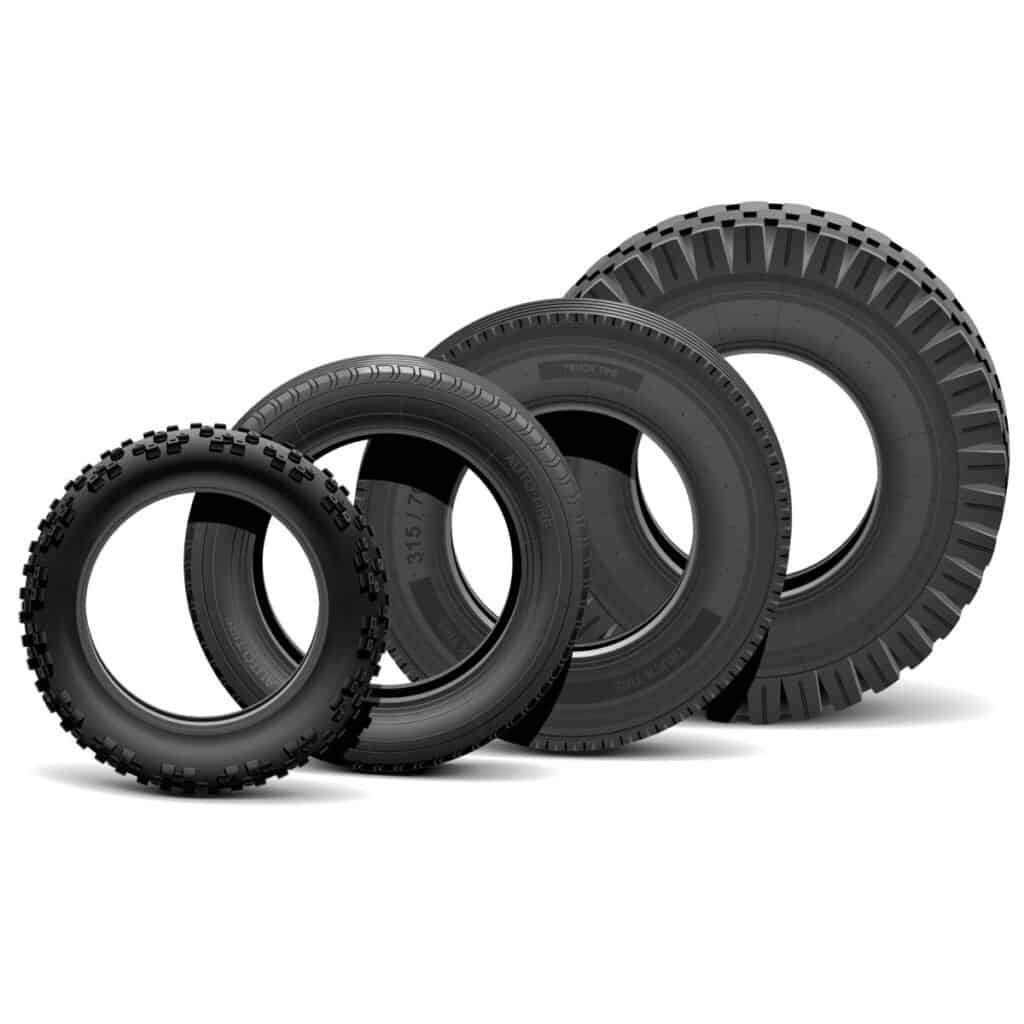Will 33 Inch Tires Affect Gas Mileage?
Gas mileage depends on several things: tire size, transmission, and drive-axle ratios. The overall fuel efficiency of a vehicle also varies depending on its intended use. An off-roading vehicle will see far more benefit to a 33inch tire than a street vehicle will.
33-inch tires increase gas mileage in rough terrain because of the added traction, but reduces gas mileage in the city. The increased size and weight of the tires require more fuel to get the car going, which reduces the vehicle’s gas mileage. However, that is not an issue when off-roading.
Some people might like larger tires simply for the aesthetics. If that is the case, more power to you! Just be aware of the effects to fuel economy and upkeep before making any mechanical changes. Let’s take a look at some of those now.
Do Tire Sizes Affect Gas Mileage?
Gas mileage is dependent on a balance between transmission, drive-axle ratios, and tire size— like a math equation. Larger tires can provide more traction in breaking and lower revolutions per minute (RPM), which is great for handling off-road terrain. However, lower RPM does not always equate to higher fuel efficiency.
Large tires, like 33-inch tires, are often heavier than smaller tires, which increases the power needed for each revolution. On paved roads, this high resistance is more of a hindrance to gas mileage than a help.
The smoother surface of streets combined with the high traction and high resistance provided by a larger 33-inch tire make for an unnecessarily force combination. In other words, your engine will be working harder than it needs to just to make the wheels go around. Because it is working harder, it uses more fuel, so your vehicle’s fuel efficiency is reduced.
In an off-roading situation, the added traction can be a good thing. The resistance a 33-inch tire will get you not only allows you to cover more uneven ground faster with higher clearance, but it also helps you maneuver otherwise dangerous paths safely. A street tire would be far less efficient than a 33-inch tire would, as the “equation” is more suited to navigating flat areas.
How Much do Tire Sizes Affect Gas Mileage?
Once more, the overall fuel efficiency depends on the context the vehicle will be used in. On regular roads, acceleration and fuel economy can drop 10% as the wheel and tire combinations get larger and heavier. Off the roads, the better handling and control provided by a larger tire and clearance will increase your MPG.
Be aware though, any change in tire size is going to require other vehicular adjustments as well. As engine performance is generally calculated for maximum MPG, changes to lift and engine suspension may also be required.
If you like the idea of a lower RPM but want to maintain the efficiency a smaller wheel can provide within the city, consider customizing your wheels. Depending on your vehicle weight, a light alloy wheel might give you the combination you are looking for.
That being said, the difference in the performance of significantly larger 33-inch tires is far more than the difference in performance between a 17-19-inch tire. With the cost of installation and the added weight decreasing fuel efficiency, it is not recommended to transition to the 33-inch tires for your daily commute vehicle.
What are the Pros and Cons of Larger Tire Sizes?

One significant and consistent advantage of having larger tires is improved braking speed. In an experiment done by Valley Chevy Dealers, they tested the acceleration and breaking speed of the same model vehicle with two different tire sizes.
While acceleration times remained the same, the larger tires were able to come to a complete stop from 60mph within 126 feet. The smaller tires only managed to stop from the same starting speed within 130 feet.
This shorter braking time and higher resistance and durability can also be a good benefit for vehicles that do a significant amount of time on the highway. Larger wheels on diesel trucks and 18-wheelers that see a lot of consistent action can actually improve their efficiency over time, even if the weight would suggest a lower MPG rating.
In reality, you likely would not notice much of a difference in fuel efficiency if you outfitted your personal vehicle with 33-inch tires. In most cases, the decrease in gas mileage would not be significant enough for the average driver to notice unless carefully measuring speed, distance, and time traveled.
If fuel economy is a big concern of yours, there are other things you can do to ensure maximum gas efficiency, like frequently checking tire pressure and keeping up with vehicle maintenance.
How Much Lift is Required to Fit 33-Inch Tires?
While the ground clearance and higher traction greatly enhance a vehicle’s off-roading capability, there is a pretty big difference between average tires and 33-inch tires. When installing a 33-inch tire on a regular vehicle (or an off-road vehicle for that matter) you are likely to run into some fit issues.
For example, you could fit 33-inch tires to a stock Jeep Wrangler JK with a lift, but it would not have the proper clearance necessary for off-roading. In reality, a 3-4 inch lift would be required for the larger tires to be functional.
The process of fitting your new tires to a vehicle can get quite complicated, depending on the vehicle. The total lift required to maintain aerodynamics and functionality is different for each make and model of vehicle, especially among off-roading vehicles. However, there are several ways to determine or estimate the total changes that will be required.
Firstly, you can ask a mechanic, preferably one who is familiar with the requirements off-roading has for a vehicle. Actually getting your vehicle in for the proper adjustments may require an appointment, so calling ahead is also a good idea.
There are also websites that have done some of the research for you! This article lists some modifications required to fit 33-inch inch tires on different makes and models of trucks and off-roading automobiles.
Switching Your Tire Size
Smaller tires, in the long run, should give you better fuel economy, all other things considered. They can tend to make your vehicle go 1-2 or even 6 miles per hour slower on average, but there are many factors to consider. (Source)
You will get more miles to the gallon with smaller tires. Your driver’s manual should give you a good idea of the tire diameter and width that is appropriate for your truck or car. While it’s true that 35-inch tires have more contact with the road, they also have other consequences that 33-inch tires may be better at. (Source)
You’d be surprised that there are a lot more things that go into your truck or car running efficiently than you would have thought like the diameter and width of the tire, the kind of tire and driving that you’re doing and the accessories pulling power away from your engine. Let’s dive in.
Tire Size and Tour MPG Ratio
Size and Weight
- Width
Many people believe that the more tire you have connecting to the road, the more RPM and thus, better gas mileage you will have, but the truth is that most tires are made today so that there isn’t much of a need to upgrade or downgrade from the tire to tire. Modern all-season tires are made to be versatile and give you more fuel economy. (Source)

The width of a tire can actually affect your gas mileage. In fact, it’s one of the better ways to increase your gas mileage rather than switching the tire diameter.
A larger width, like with a 35-inch tire, gives you more control over the road by giving your vehicle more contact with the road and can help guard against sliding.
The extra contact on the road is well worth it to those who are looking for a good way to control gas mileage, but another consideration for wider tires is that they are more prone to hydroplane. (Source)
- Weight
Another factor that will affect how well your engine uses gas is, of course, weight. You know that it doesn’t make sense to carry around extra stuff in your car because it weighs it down and decreases fuel efficiency, but what about your tires that are always on your vehicle.
Sure, you may have an engine that is built to be durable and has enough weight capacity to carry everything as a work vehicle, but many times those giant tires are more accessories than necessary as they can weigh you down, especially if most of your driving is done on the freeway.
Torque and Your MPG Ratio
- Torque
With so many variables to consider, it’s difficult to know where to begin, but, if you’ve already controlled for the conditions that you’re driving in and other things that could be overworking your engine, you can start looking at your tires for another way to save on gas mileage.
The most important thing to know about your car’s tire is to know the kind of engine you’re working with, for example, each engine is built to handle a certain amount of twisting force, also known as torque. Engines with smaller torque capacity will spin at lower RPMs for a smaller wheel.
If you’re thinking about switching from a 35-inch tire down to a 33-inch tire, you’ll want to consider your engine along with the supposed new gas mileage. So, those old remodeled trucks that you’ve seen with the lifts and the fancy giant tires are having to over-perform to turn that large tire. At the same time, engines with more torque would not be performing at peak torque and perform below anticipated RPM with smaller tires.
Your radio and air conditioner can affect gas mileage as well. Taller tires can also give you more wind resistance, which is not good for gas mileage as the vehicle is raised farther up from the ground. There are many variables that play into fuel economy on a car, so, it’s a little bit difficult to pick out just one, but the size of your tire is one of them.
Other Tire Features That Affect Your MPG Ratio
Air Pressure

Everyone has heard that they need to keep their air pressure up because it saves on gas and it’s dangerous to drive with low air in your tires, but it’s still true. Low tires create more resistance on the road.
You want to have your air pressure checked regularly especially if you don’t have a sensor on your car to tell you if they’re low.
Even if you do have a sensor on your car, you’ll want to check it regularly because if it’s gone off, it’s because the air is 25% lower than where it needs to be. It’s a good idea to check it once a month.
While you’re looking over which kinds of tires will work best for you, don’t forget to keep them pumped up so that you can drive safely and use less fuel.
Treads
When your tire treads are low, not only is it unsafe to drive the car because it’s more prone to sliding and stopping quickly, it’s also less easy to get up to speed. With this lack of control over your vehicle, you may find that your gas mileage goes up significantly.
The common way to check if your tread is too low is by placing a penny in the groove of the tire tread to see if the tread comes above Abraham Lincoln’s head. If it’s below or on that line, you may want to look at getting new tires.
Again with tread, some tires are built for off-roading and have loads more tread on them than normal street-driving cars do. The cars that have special tires on them meant for off-roading will obviously not get very good fuel economy with city driving.
